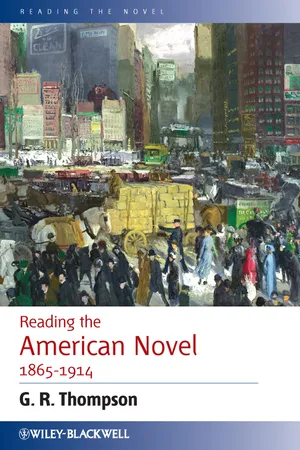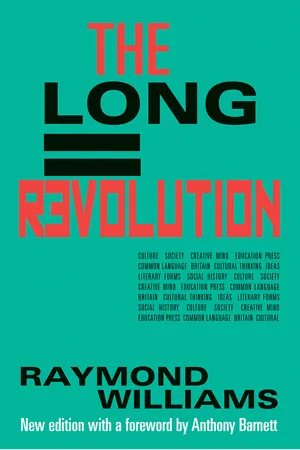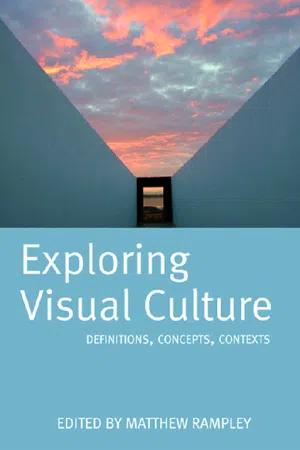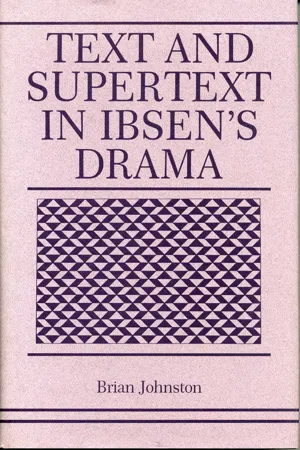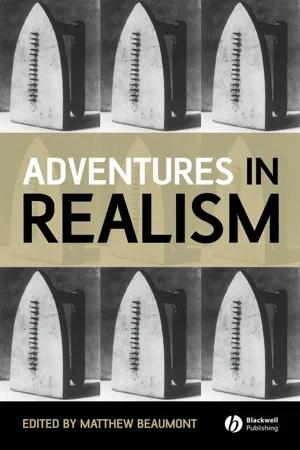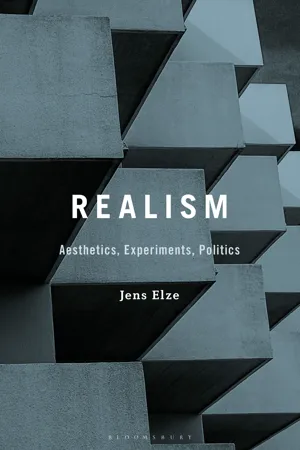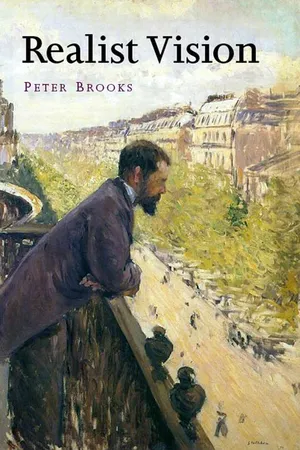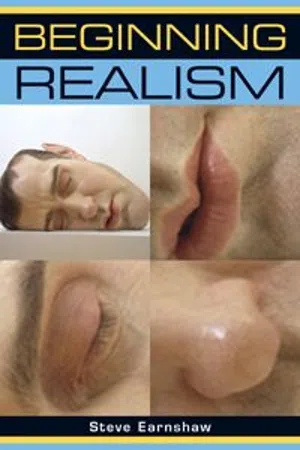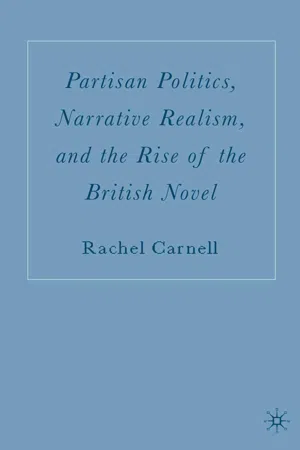Literature
Realism
Realism in literature is a movement that emerged in the 19th century, aiming to depict everyday life and society with accuracy and detail. It focuses on portraying characters and events in a way that reflects the real world, often addressing social issues and human experiences. Realist writers strive to present a truthful and objective representation of the world, often using precise and unembellished language.
Written by Perlego with AI-assistance
Related key terms
1 of 5
12 Key excerpts on "Realism"
- eBook - ePub
- G. R. Thompson(Author)
- 2011(Publication Date)
- Wiley-Blackwell(Publisher)
Chapter 2 Of Realism and Reality Definitions and ContextsAs a literary term, Realism normally refers to a theory and practice of fiction in which the artistic goal is to portray “life as it is” – rather than intensified or as it should be – and in simple direct language rather than striving for striking metaphors and indulging in rhetorical flourishes. The elevated subject matter of classic tragedy, or the poetic elements of optative romanticism, or the sentimental aspects of domestic novels and romances, or the hair-raising events of gothic romances were to be downplayed or avoided in favor of the everyday, average, prosaic aspects of life.Realism in this sense was especially prominent in France, England, the United States, and Russia from about the mid-nineteenth century to the 1930s and 1940s (and beyond). But there are realistic, mimetic elements in works written centuries before: in the Iliad and the Odyssey (c. eighth century bc), in the plays of Sophocles (496–406 BC), in Boccaccio's Decameron tales (1351–1353) and Chaucer's Canterbury Tales (c. 1387–1400), in the plays of Shakespeare (1564–1616) and other Renaissance dramatists. Don Quixote (Part I, 1605; Part II, 1615) presents a hybrid form of a romance and novel in which the interplay of worldviews is centrally informed by the mixture of Realism with idealized romanticism. Many consider this seventeenth-century work the cornerstone of the modern novel.In the English-speaking world, literary historians generally point to the principal eighteenth-century British novelists as anticipating the nineteenth century in the development of modern Realism. In American literature, the primary meaning of Realism indicates a period: the historical era from about a decade after the American Civil War to a decade or two after World War I.1 But literary Realism, even when confined to a historical period, is not a single undiversified idea or theoretical program or movement. In both Britain and America, major fictional forms partaking of both Realism and romance included the domestic novel , the novel of manners , and the sentimental novel . In America there was an important, predominantly realist, movement toward regionalism , within which broad rubric a form called local color is sometimes distinguished. Both centrally involve a forceful vernacular style (idiomatic spoken language), often in dialect (regional or ethnic idiom). In addition, we can identify, at the minimum, several forms of realist theory and practice in Europe and America: objective Realism , compassionate Realism , benevolent Realism , and sentimental Realism . There is also a distinction to be made between intense “social reformist” Realism and “quiet” Realism. Variations on Realism and anti-romance are also in tension with, or in complementary relation to, impressionism and expressionism and most especially naturalism .2 - eBook - ePub
- Raymond Williams(Author)
- 2014(Publication Date)
- Parthian Books(Publisher)
7 Realism and the Contemporary NovelThe centenary of ‘Realism’ as an English critical term occurred but was not celebrated in 1956. Its history, in this hundred years, has been so vast, so complicated and so bitter that any celebration would in fact have turned into a brawl. Yet Realism is not an object, to be identified, pinned down and appropriated. It is, rather, a way of describing certain methods and attitudes, and the descriptions, quite naturally, have varied, in the ordinary exchange and development of experience. Recently, I have been reconsidering these descriptions, as a possible way of defining and generalising certain personal observations on the methods and substance of contemporary fiction. I now propose to set down: first, the existing variations in ‘Realism’ as a descriptive term; second, my own view of the ways in which the modern novel has developed; third, a possible new meaning of Realism.There has, from the beginning, been a simple technical use of ‘Realism’, to describe the precision and vividness of a rendering in art of some observed detail. In fact, as we shall see, this apparently simple use involves all the later complexities, but it seemed, initially, sufficiently accurate to distinguish one technique from others: Realism as opposed to idealisation or caricature. But, also from the beginning, this technical sense was flanked by a reference to content: certain kinds of subject were seen as Realism, again by contrast with different kinds. The most ordinary definition was in terms of an ordinary, contemporary, everyday reality, as opposed to traditionally heroic, romantic or legendary subjects. In the period since the Renaissance, the advocacy and support of this ‘ordinary, everyday, contemporary reality’ have been normally associated with the rising middle class, the bourgeoisie. Such material was called ‘domestic’ and ‘bourgeois’ before it was called ‘realistic’, and the connexions are clear. In literature the domestic drama and, above all, the novel, both developing in early eighteenth-century England with the rise of an independent middle class, have been the main vehicles of this new consciousness. Yet, when the ‘realist’ description arrived, a further development was taking place, both in content and in attitudes to it. A common adjective used with ‘Realism’ was ‘startling’, and, within the mainstream of ‘ordinary, contemporary, everyday reality’ a particular current of attention to the unpleasant, the exposed, the sordid could be distinguished. Realism thus appeared as in part a revolt against the ordinary bourgeois view of the world; the realists were making a further selection of ordinary material which the majority of bourgeois artists preferred to ignore. Thus ‘Realism’, as a watchword, passed over to the progressive and revolutionary movements. - eBook - PDF
Exploring Visual Culture
Definitions, Concepts, Contexts
- Matthew Rampley(Author)
- 2019(Publication Date)
- Edinburgh University Press(Publisher)
8. Representation and the Idea of Realism Neil Mulholland Introduction First follow Nature, and your judgement frame By her just standard, which is still the same. Alexander Pope, An Essay on Criticism (1711) ‘Realism’ is one of the most commonly used cultural terms and exercises a partic-ularly powerful hold over the ways that people judge and exploit visual culture. Today, it is very often used encouragingly as a way of praising a particular work of art, photograph, television programme or film. To most people, its meaning is common sense and uncomplicated. For some, ‘Realism’ conjures up connotations of truth, straightforwardness, sincerity and honesty. For others ‘Realism’ takes its cues from the present; it is based upon everyday experience rather than myth. ‘Realism’ may be characterised by its gritty social or political message, an interest in ‘ugliness’ or contemporary urban living. Such readings of the term ‘Realism’ might originate in the literary and artistic movement correlated with the revolu-tionary events of 1848, which was associated with French radicals such as the socialist painter Gustave Courbet, the republican caricaturist Honoré Daumier or writers such as Emile Zola and Charles Baudelaire. 1 As an artistic movement, Realism was tied closely to the steady growth of faith in modern political and natural sciences, to the belief that the world could be observed objectively and factually. Gustave Courbet painted The Stonebreakers in 1851 (Figure 8.1) from direct observation of the rural labouring classes, while Emile Zola’s novel L’Assommoir (1876) was based on facts and figures relating to the poverty and squalor suffered by people living in the slums of Paris. Writers and artists such as Zola and Courbet used their empirical observations to make barbed political commentary on contemporary society. - eBook - PDF
How to Make Believe
The Fictional Truths of the Representational Arts
- J. Alexander Bareis, Lene Nordrum, J. Alexander Bareis, Lene Nordrum(Authors)
- 2015(Publication Date)
- De Gruyter(Publisher)
One can falsify realist descriptions by looking and seeing if they correspond to reality: Look within and life, it seems, is very far from being ‘like this’. Examine for a moment an ordinary mind on an ordinary day. The mind receives a myriad impressions – trivial, fan-tastic, evanescent, or engraved with the sharpness of steel. (Woolf 1966, 106) The Concept of Literary Realism | 27 So, if one opens up the concept of reality as it occurs in the criterion ‘providing a truthful/objective representation of some aspect of reality’, this criterion can-not be used to distinguish between the modes of writing that literary critics have been identifying as Realism and modernism. The concept of Realism has then lost its usefulness as a critical concept. The attack on literary Realism by post-modernist critics was part and parcel of a wider attack on humanism. An unanalysed concept of Realism with its ap-parent conceptual link to reference and truth provided an easy target for critics who wanted to undermine humanist values. And the response to post-modernist critics was not really a defence of Realism, but, in Gerald Graff’s (1979, 193) words, “a realist defence of humanism”. And in this struggle the concept of Realism was itself a casualty. When the concept of Realism is put under pressure, as it was by Lukács and post-modernist critics, it breaks, and it breaks at a very important point. A concept of Realism which licences the con-clusion that modernism leads to the destruction of literature, that only naïve readers can find any satisfaction in realist literary works, or that realist novels are not really realist, or that, contrary to all empirical evidence, Realism is dead, is simply useless as a critical tool. The effect of the debate between post-modernist critics and the defenders of Realism was to derail any fruitful discussion of Realism for thirty years. - eBook - PDF
- Brian Johnston(Author)
- 1989(Publication Date)
- Penn State University Press(Publisher)
The fewer details of realist art seem richer in implication, the "terms" of the method more loaded with significance. The older, looser method of a Balzac or Dickens or George Eliot seemed to address itself to a possible "general public": The new Realism seems a product of, and for, the alienated consciousness of the modern spirit, whose origins can be traced in postrevolutionary European thought. This new literature of the alienated spirit stands in highly critical relation- ship to the social reality it portrays, as an attack upon that reality or, in Michel Foucault's phrase, as a "counter discourse" to it. A study such as M. H. Abrams's Natural Supernaturalism reveals the emergence of this alienated spirit in British and German Romanticism, Schiller's essay On Naive and Sentimental Poetry and Hegel's The Phenomenology of Mind being classic docu- ments of the movement on the Continent. We see the continua- tion of this movement, in the theater, in the works of Schiller, Kleist, Buechner, Richard Wagner, and Ibsen, up to the avant- garde dramatists of modern times. Realism was an expression of this movement, one of its significant stages, and it is because of the peculiar richness of the realist aesthetic as an expression of this modem spirit that Ibsen remains as central to the modern tradition as, say, Manet and Cezanne remain central to the tradi- tion of modern painting. In a recent study of Realist painters, Charles Rosen and Henri Zerner observe that, in the authentic realists, the "subject" loses its importance, while the artistic act itself becomes the subject, assuming, in fact, the place of honor once held by the subject. If contemporary life was to be represented with its banal- ity, ugliness and mediocrity undistorted, then the aes- thetic interest had to be shifted from the objects repre- Ibsen's Realist Aesthetic 31 sented to the means of representation. - eBook - PDF
- Matthew Beaumont(Author)
- 2008(Publication Date)
- Wiley-Blackwell(Publisher)
Introduction: Reclaiming Realism Matthew Beaumont Realism is an issue not only for literature: it is a major political, philosophical and practical issue that must be handled and explained as such – as a mat-ter of general human interest. Bertolt Brecht In a useful collection of historical documents about Realism in literature that he compiled almost half a century ago, George J. Becker complained that “the subject of Realism is not especially congenial to the critics of our day” (Becker 1963: 3). He grumbled that one type of critic in par-ticular – not perhaps ideologically opposed to Realism, like those that stra-tegically promoted the modernist movement – had nonetheless “become bored with it and finds that this subject, always rather obvious and simple-minded, need no longer engage the subtle mind of the literary scholar” (Becker 1963: 3). Becker might have been thinking of formal-istic critics like Northrop Frye, for whom Realism was in some fundamental sense anti-literary: “One of the most familiar and important features of literature,” Frye had declared in his famous Anatomy of Criticism in 1957, “is the absence of a controlling aim of descriptive accuracy” (Frye 1990: 75). Becker’s complaint also proved to be prophetic, though. In the succeeding decades, philosophers and critics both opposed to real-ism and simply uninterested in it continued to replicate, and indeed to reinforce, the attitude that he had characterized. In an influential essay from 1982, for instance, Jean-François Lyotard collapsed Realism into a superficial conception of mimesis, loftily insisting that it “always stands somewhere between academicism and kitsch”; Realism’s “only definition,” he concluded, “is that it intends to avoid the question of reality implic-ated in that of art” (Lyotard 1984: 75). - eBook - PDF
- Jens Elze(Author)
- 2022(Publication Date)
- Bloomsbury Academic(Publisher)
While Realism is thus deeply committed to reality, it cannot from this perspective be charged—as will be clear by now through its problematic relation to “representation” and “resemblance”— as operating with a simplistic and ideologically dubious reflectionism. 5 INTRODUCTION Rather, Realism as a political aesthetics, only makes visible and sensible as if for the first time—and insofar only projects and constructs—relations, thoughts, people, or things that have not existed in prior versions of reality. This notion of Realism clearly unsettles the polarity between representation and invention, reflection and construction, or poeisis and mimesis, in which Realism is often logged in as the lesser term of these hierarchical binaries. Realism, then, is absolutely about making reality readable and sensible, but not in the tired sense of “reproducing facts,” 33 transparency, consensus, resemblance, or easy readability that representational understandings of Realism—especially as formulated by its detractors—often assume, that equal all Realism to the easy pleasures of plot driven and “life-like” airport literature and the ideological work they perform in naturalizing familiar visions of reality. 34 The problem with such assumptions is not only that transparency is dependent on conventions and codes as Barthes has famously observed in S/Z; 35 codes that will change over time and with cultures, as Ulka Anjaria has demonstrated in her Realism in the 20th Century Indian Novel and Nasrin Babakhani will make clear in her conception of magical Realism as cultural Realism in this volume. Rather, Realism is not even about projecting an easily readable and consensual notion of reality. - eBook - PDF
- Peter Brooks(Author)
- 2008(Publication Date)
- Yale University Press(Publisher)
It is not that there haven’t been kinds of Realism, and impulses toward Realism, throughout history—see Chaucer, see Rabe-lais, see Pieter Bruegel the Elder, or American photoRealism of the 1970s. The instinct of realist reproduction may be a constant in the human imagi-nation (though at times it seems to be wholly dismissed or repressed, as in Byzantine art). What seems to change with the coming of the modern age—dating that from sometime around the end of the eighteenth century, with the French Revolution as its great emblematic event, and Jean-Jacques Rousseau and then the English Romantic writers as its flag bearers—is a new valuation of ordinary experience and its ordinary settings and things. This new valuation is of course tied to the rise of the middle classes to cultural influence, and to the rise of the novel as the preeminent form of modernity. What we see at the dawn of modernity—and the age of revolutions—is the struggle to emerge of imaginative forms and styles that would do greater justice to the language of ordinary men (in William Wordsworth’s terms) and to the meaning of unexceptional human experience. Keeping a register of what happens every day, Rousseau once described his one novel. This means finding a certain dignity in the ordinary, as in Wordsworth’s strange cast of peasants. But it can also mean attention to the ugly, that which doesn’t fit the standard definitions of the beautiful. George Eliot in Adam Bede famously compares her novel to Dutch genre painting, but even that kind of humble picturesqueness seems too prettified for what such late realists—or ‘‘naturalists’’—as Emile Zola and George Gissing seek. Zola proposed that every writer saw life through a certain kind of screen.Whereas the Romantic screen gave rosy coloring to what was viewed through it, the Realism and Representation 8 Naturalist screen was plainly transparent—yet, Zola admits, with a certain effect of graying, making more somber what was perceived through it. - eBook - PDF
- Carlos Reis(Author)
- 2020(Publication Date)
- De Gruyter Mouton(Publisher)
Chapter IV Narrative and realist representation 1. Marxism and Realism 1.1. To speak of realist representation, in the present context, does not imply that we will be presenting an exhaustive account of the problematic of Realism, in all its varied and complex facets. It is well known that this is a field of theoretical endeavour full of difficulties and contradictions; the writers themselves speak thus of the former: Between art and reality there is always an abyss with no bridge. On this side, a world with a thousand versions, mild even when the words are daggers, the colours lightning, the cries of despair. On the other side, a presence without rhetoric, of one face only, inflexible and permanent. 1 Therefore, it is not for us to rehearse here the debate on the meanings encompassed by the term Realism, on its polysemy or on the historical variations it has suffered; distinguished authors like René Wellek and J. R Stern, Roger Garaudy and André Gisselbrecht have already done that, the first with profuse historico-literary documentation, 2 the last two locating the problem in the domain of the relationship between Material-ism and artistic Realism. We are interested in another route, perhaps one with some unexplored areas, at least from the perspective we will be taking here: we are referring to the concept of Realism as an artistic category and, in a second phase, to its connections with narrative. When Pierre Macherey states that the production of an impression of reality, which gives the literary work its necessity, belongs to language in general, and the particular use that the writer makes of it cannot be distinguished, 3 his words suggest an attempt to expand realist representa-tion (or the possibility of it) beyond an ideological system and the limits of a specific historical period. - eBook - ePub
- Steven Earnshaw(Author)
- 2013(Publication Date)
- Manchester University Press(Publisher)
Just because we live our lives in the manner which suggests that the majority subscribe to everyday Realism, it does not mean that art and literature are obliged to represent the world in this way. The opposite argument indeed might have more force, for if everyday Realism is our unthinking, habitual mode of existence, art forms which challenge this can alert us to our somewhat uncritical state, showing alternative points of view, different kinds of perception, different kinds of knowledge, alternative views of linguistic usage and narrative construction, different cognitive approaches to the world and human behaviour. I do not think that any of this can be gainsaid: modernist and postmodernist aesthetics, and the philosophical and critical ideas that lie behind these artistic modes, have shown this. The gap between the Realists and ourselves – and the realists of the 1930s and 1950s – is that there was a social necessity to work from within the Realist aesthetic. Although arguments over accessible art continue to rage, and Realism is seen as the primary aesthetic for popular art, ‘Realism’ has few of the constraints of nineteenth-century Realism and tends to once more be conflated with mimesis and being adjudged ‘realistic’. As long as things look like the things we know and behave in a plausible manner, in a spatio-temporal universe we believe to continue to exist, the art is acceptable. Such a realist aesthetic maintains some of the tenets of its nineteenth-century forbear, but lacks the self-conscious urgency and exploration of a new aesthetic and, indeed, does not feel the need to defend itself as an aesthetic.Realist writers want to give us the real, and the more interesting ones understand that they cannot rely on hackneyed methods of representation. They are no doubt perfectly aware that language is not transparent, that it is a mediation, but that still does not accord with many people’s psychological, cognitive and emotional experience of reality. Language and representation are the real, and it remains contentious to argue that modern Realism deliberately, and rather sinisterly, conflates representation with Realism. A novel such as Zadie Smith’s On Beauty (published in 2005) is a contemporary novel in the realist tradition. It deals directly with many of the social problems of the contemporary world: the effects of global capitalism, the place of religion in the modern world, questions about class, gender, race, age, family relations, and the nature of representation. It knows its literary and critical theory, yet still presents all this within the realist mode of a belief in its ability to re-present a recognisable world in an accessible language. That is a lot of ground to cover. Nevertheless, unlike Joshua Ferris’s novel, it is not aesthetically experimental, despite its knowingness, and is undoubtedly more typical of contemporary realist literature than Ferris.Has the nature of reality changed?
One of the reasons readers found Darwin’s argument for evolution in The Origin of Species - R. Carnell(Author)
- 2006(Publication Date)
- Palgrave Macmillan(Publisher)
Even within a given period and a given selection of novels, readers have not necessarily agreed about what creates a feeling of reality, nor have subsequent critics agreed upon what seems “realistic” in works produced in earlier eras. Across the centuries, some reviewers and scholars have found 8 THE RISE OF THE BRITISH NOVEL Pamela’s first-person narrative compelling and believably voiced, while others have found implausible Richardson’s attempts at “writing to the moment.” More generally, a feeling of “reality” or “plausibility” has been ascribed by critics sometimes to a third-person and sometimes to a first-person narrator, and sometimes to a free-indirect style that marries the two. In traditional scholarship, Realism is sometimes identified with an apparently objective or ironic narrative detachment, some- times with a “stream of consciousness” monologue, and sometimes with a narration perceived as too subjective to be “reliable.” Similarly, the depiction of “realistic” character has been ascribed sometimes to an abundance and sometimes to a scarcity of detail. However, in mid- twentieth-century accounts of narrative Realism, realistic character was typically conceived of as both concrete and universal, hence implicitly apolitical, or at least nonpartisan. When considering the connection between “literary” and “political” history, it is useful to remember that the impulse to draw a sharp division between the literary and the political is a twentieth-century phenomenon, one that has affected the way we study both literature and social history. 34 Scholarship on the connection between the literary and the political public spheres, for example, has sometimes drawn on the popular twentieth-century assumption that there once was a “literary” sphere inculcating “affective humanism” which was separate from, although necessary to, a “public” sphere of commercial and political concerns.- eBook - ePub
Reading Between the Lines
A Christian Guide to Literature
- Gene Edward Veith Jr.(Author)
- 2013(Publication Date)
- Crossway(Publisher)
It is not possible for an author to simply transcribe the objective world in a purely passive way. The author’s beliefs and assumptions keep intruding themselves, actively shaping perceptions and how they are conveyed. A writer may try to be a mirror, but cannot help also being a lamp. If a writer claims to be a realist, we must ask what that writer considers to be real. The rise of Darwinism in the nineteenth cen tury led to a literary movement known as naturalism. According to this view, only nature and nature’s laws are real. The theory of evolution taught that human beings were nothing more than animals, that human life is determined by physical laws outside of the control of the individual, and that life consists of conflict in which only the fittest will survive. This brand of Realism, exemplified by Emile Zola, Stephen Crane, and Jack London, was often brilliant in its vivid descriptions, its lifelike evocations of the natural world, and its penetrating lan guage. The atmosphere of their works is generally bleak and hopeless; the characters are swept up by deterministic forces outside their con trol. Although the naturalistic writers accepted a materialistic world view, their spirits often rebelled against its implications, resulting in works of enraged despair at such an empty universe.A related view of reality was that of Karl Marx, who stressed a determinism based not so much on nature but on social forces. This helped inspire another group of writers whom we could call social real ists. At their best, these writers portrayed the dynamics of social life with penetrating insight or exposed social injustice. Sinclair Lewis sav aged small town America in novels such as Babbitt (the story of a busi nessman’s attempted rebellion against his drab middle class life) and Elmer Gantry (the story of a hypocritical evangelist who is ruined by his affair with a church secretary—notice how life sometimes imitates art). Upton Sinclair’s The Jungle, a story of the brutal conditions faced by immigrants in the meatpacking plants of Chicago, led to legislation regulating the food industry (although Sinclair’s purpose was to pro mote socialist political reform).
Index pages curate the most relevant extracts from our library of academic textbooks. They’ve been created using an in-house natural language model (NLM), each adding context and meaning to key research topics.
